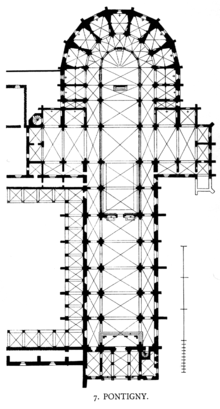Pontigny Abbey


The Cathedral-Abbey of the Assumption in Pontigny (French: Cathédrale-abbatiale de Notre-Dame-de-l’Assomption à Pontigny), commonly known as Pontigny Abbey, was a Cistercian monastery located in Pontigny on the River Serein, in the present diocese of Sens and department of Yonne, Burgundy, France. Founded in 1114, it was the second of the four great daughter houses of Cîteaux Abbey.
History
Hildebert (or Ansius), a canon of Auxerre, petitioned Abbot Stephen Harding of Cîteaux to found a monastery in a place he had selected for this purpose. Accordingly in 1114 Saint Stephen sent twelve monks under the guidance of Hugh of Mâcon, the first abbot and a friend and kinsman of Bernard of Clairvaux, to establish the new foundation. Under Abbot Hugh and his successor, Guichard, the new monastery developed such a reputation for sanctity that it attracted sufficient numbers to be able to establish another twenty-two Cistercian monasteries.
Many members of the community of Pontigny went on to occupy high positions in the church and many distinguished personages sought refuge there. Amongst the former were, for example, Blessed Hugh of Mâcon, Bishop of Auxerre (d. 1151); Girard Mainard,[1] Cardinal Bishop of Praeneste (d. 1202); and Robert, Cardinal Titular of St. Pudentiana (d. 1294). The latter included three Archbishops of Canterbury: Saint Thomas Becket, Stephen Langton and Saint Edmund of Abingdon, who was buried there.
Over the centuries, however, the original strict discipline relaxed, especially from 1456, when the abbey was given in commendam. In 1569 it was pillaged and burnt by the Huguenots, only the relics of Saint Edmund being saved. Partly restored, it continued in existence until it was suppressed during the French Revolution. The monastic buildings were largely destroyed, but the church was saved, due to the respect in which the cult of Saint Edmund was still held, and continued in use after the Revolution as a parish church.
In 1843 a community of the Fathers of St. Edmund was established here by J. B. Muard.
In 1909 the site was bought by the philosopher Paul Desjardins, who from 1910 to 1914 held meetings every year at the abbey, known as "Decades of Pontigny", or conferences of ten days' duration, where the intellectual élite of Europe met including inter alia Antoine de Saint-Exupéry, Jean-Paul Sartre, Simone de Beauvoir, T. S. Eliot, Thomas Mann, Heinrich Mann, Nikolai Berdyaev. Between 1922 and 1939, after the end of World War I, Desjardins reorganized the conferences to evaluate the future of Europe, annually bringing together such notables as Charles du Bos, Roger Martin du Gard, André Gide, Paul Langevin, André Malraux, François Mauriac, Jacques Rivière and Alice Voinescu, among others.[2]
Burials
Among the burials in the abbey church are the following:
- Adèle of Champagne (1145–1206), queen of Louis VII of France
- Saint Edmund of Abingdon (c. 1180–1240), Archbishop of Canterbury
- Paul Desjardins (1859–1940)
Viticulture
Next to their religious duties the monks of Pontigny were also much occupied in the cultivation of vineyards. They established the original vineyard from which the present Chablis wine traces its descent.
Pilgrims' Route
The abbey is a stopping-point on one of the pilgrimage routes to Santiago de Compostela.
Notes
- ↑ The Cardinals of the Holy Roman Church - Suburbicarian Dioceses and Cardinal Patriarchs of Oriental Rite
- ↑ Georgescu, Diana (2006). "Voinescu, Alice Steriadi (1885–1961)". In de Haan, Francisca; Daskalova, Krassimira; Loutfi, Anna. Biographical dictionary of women's movements and feminisms in Central, Eastern, and South Eastern Europe: 19th and 20th centuries. Budapest, Hungary: Central European University Press. p. 609. ISBN 978-9-637-32639-4 – via Project MUSE. (Subscription required (help)).
External links
| Wikimedia Commons has media related to Pontigny Abbey. |
- (in German) Pictures of Pontigny
- (in French) History of the Abbey
- (in French) Architecture of Pontigny
- Cistercian Foundation Abbey of Pontigny - History & Photos
![]() This article incorporates text from a publication now in the public domain: Herbermann, Charles, ed. (1913). "Abbey of Pontigny". Catholic Encyclopedia. New York: Robert Appleton.
This article incorporates text from a publication now in the public domain: Herbermann, Charles, ed. (1913). "Abbey of Pontigny". Catholic Encyclopedia. New York: Robert Appleton.
Coordinates: 47°54′34″N 3°42′52″E / 47.90944°N 3.71444°E